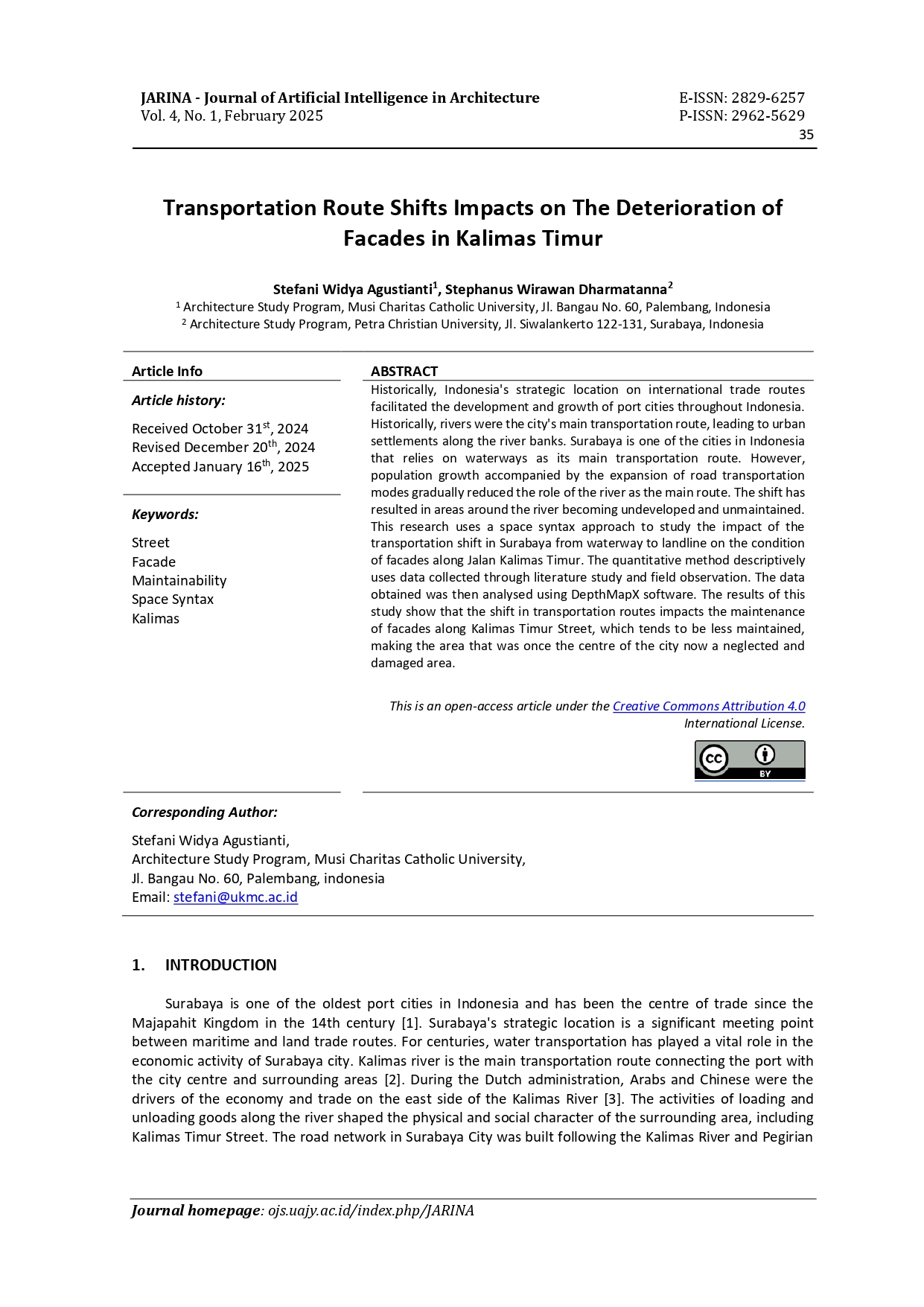Transportation Route Shifts Impacts on The Deterioration of Facades in Kalimas Timur
DOI:
https://doi.org/10.24002/jarina.v4i1.10128Keywords:
Street, Facade, Maintainability, Space Syntax, KalimasAbstract
Historically, Indonesia's strategic location on international trade routes facilitated the development and growth of port cities throughout Indonesia. Historically, rivers were the city's main transportation route, leading to urban settlements along the river banks. Surabaya is one of the cities in Indonesia that relies on waterways as its main transportation route. However, population growth accompanied by the expansion of road transportation modes gradually reduced the role of the river as the main route. The shift has resulted in areas around the river becoming undeveloped and unmaintained. This research uses a space syntax approach to study the impact of the transportation shift in Surabaya from waterway to landline on the condition of facades along Jalan Kalimas Timur. The quantitative method descriptively uses data collected through literature study and field observation. The data obtained was then analysed using DepthMapX software. The results of this study show that the shift in transportation routes impacts the maintenance of facades along Kalimas Timur Street, which tends to be less maintained, making the area that was once the centre of the city now a neglected and damaged area.
References
[1] H. Handinoto and S. Hartono, “SURABAYA KOTA PELABUHAN (SURABAYA PORT CITY). Studi tentang perkembangan bentuk dan struktur sebuah kota pelabuhan ditinjau dari perkembangan transportasi akibat situasi politik dan ekonomi dari abad 13 sampai awal abad 21.,” Dimens. (Journal Archit. Built Environ., vol. 35, no. 1, pp. 88–99, 2007, doi: 10.9744/dimensi.35.1.88-99.
[2] C. Puspita and S. W. Dharmatanna, “IDENTIFIKASI URBAN TISSUE PADA KAWASAN KREMBANGAN SELATAN,” Rustic J. Arsit., vol. 4, no. 1, pp. 1–13, 2023, [Online]. Available: https://repository.petra.ac.id/20680/.
[3] N. K. Adi, “Peranan Sungai Kalimas Sebagai Sarana Transportasi Sungai Kota Surabaya Tahun (1900-1952),” AVATARA J. Pendidik. Sej., vol. 7, no. 1, 2019, [Online]. Available: https://jurnalmahasiswa.unesa.ac.id/index.php/avatara/article/view/27163.
[4] I. R. M. Anwari, “Sistem Transportasi Darat Perkotaan Surabaya Masa Kolonial 1900-1942,” Mozaik Hum., vol. 17, no. 02, pp. 214–237, 2017.
[5] R. Anggeraeni, N. Fadhly, and A. Achmad, “Analisis Jalur Trans Kutaraja di Kota Banda Aceh di Tinjau Dari Pengembangan Wilayah,” J. Penelit. Transp. Darat, vol. 23, no. 1, pp. 88–105, 2021, doi: 10.25104/jptd.v23i1.1765.
[6] C. Puspita and S. W. Dharmatanna, “Effect of Population Density and Urban Intensity on Building Typology in South Krembangan Area,” vol. 6, no. 1, pp. 23–35, 2024, doi: 10.14710/jadu.v6i1.20807.
[7] M. Waruwu, “Pendekatan Penelitian Pendidikan: Metode Penelitian Kualitatif, Metode Penelitian Kuantitatif dan Metode Penelitian Kombinasi (Mixed Method),” J. Pendidik. Tambusai , vol. 7, no. 1, pp. 2896–2910, 2023.
[8] Sugiyono, Metode Penelitian Kuantitatif Kualitatif dan R&D. Bandung: Alfabeta, 2010.
[9] Sugiyono, Metode Penelitian Pendidikan (Pendekatan Kuantitatif, Kualitatif dan R&D). Bandung: Alfabeta, 2015.
[10] A. R. Adi, “Optimalisasi Aksesibilitas Berbasis Space Syntax: Studi Kasus Pedestrian di Sekitar Planetarium UIN Walisongo,” J. Arsir, vol. 7, pp. 14–27, 2023, [Online]. Available: https://doi.org/10.32502/arsir.v7i1.5207.
[11] A. van Nes and C. Yamu, Introduction to Space Syntax in Urban Studies. Switzerland: Springer Nature Switzerland AG, 2021.
[12] W. C. Yudhanta, “PENGARUH KONFIGURASI DAN VISIBILITAS RUANG PADA AKSESIBILITAS, Studi Kasus pada Kawasan XT Square Yogyakarta,” J. Arsit. KOMPOSISI, vol. 12, no. 1, p. 67, 2018, doi: 10.24002/jars.v12i1.1647.
[13] D. D. Permata, E. N. Al-Fitriani, F. A. Andriana, and A. N. Kurniawan, “Connectivity dan Integrity dalam Space Syntax pada Bangunan Sekolah Al-Biruni Cerdas Mulia Bandung,” RUAS, vol. 20, no. 1, pp. 55–64, 2022, doi: 10.21776/ub.ruas.2022.020.01.6.
[14] M. Kusyanto, “Kajian Fasade Bangunan Pecinan Di Kota Demak,” Tatal, vol. 8, no. 2, pp. 91–101, 2018, [Online]. Available: https://e-jurnal.unisfat.ac.id/index.php/jt/article/view/136.
[15] D. Harun, Antariksa, and A. M. Ridjal, “Pelestarian Bangunan Masjid Tuo Kayu Jao Di Sumatera Barat,” J. Mhs. Jur. Arsit. Univ. Brawijaya, vol. 4, no. 2, p. 5, 2016.
[16] F. Mutia, “PELESTARIAN KAMPUNG BATIK JETIS BERBASIS PARTISIPASI MASYARAKAT,” Institut Teknologi Sepuluh Nopember Surabaya, 2017.

Downloads
Published
How to Cite
Issue
Section
License
Copyright (c) 2025 Stefani Widya Agustianti, Stephanus Wirawan Dharmatanna

This work is licensed under a Creative Commons Attribution 4.0 International License.
Authors who publish with this journal agree to the following terms:
1.Authors retain copyright and grant the journal right of first publication with the work simultaneously licensed under a Creative Commons that allows others to share the work with an acknowledgement of the work's authorship and initial publication in this journal.
2.Authors are able to enter into separate, additional contractual arrangements for the non-exclusive distribution of the journal's published version of the work (e.g., post it to an institutional repository or publish it in a book), with an acknowledgement of its initial publication in this journal.
3.Authors are permitted and encouraged to post their work online (e.g., in institutional repositories or on their website) prior to and during the submission process, as it can lead to productive exchanges, as well as earlier and greater citation of published work (See The Effect of Open Access).
















